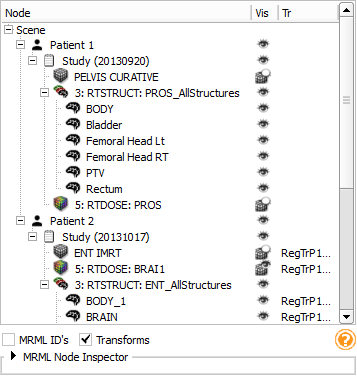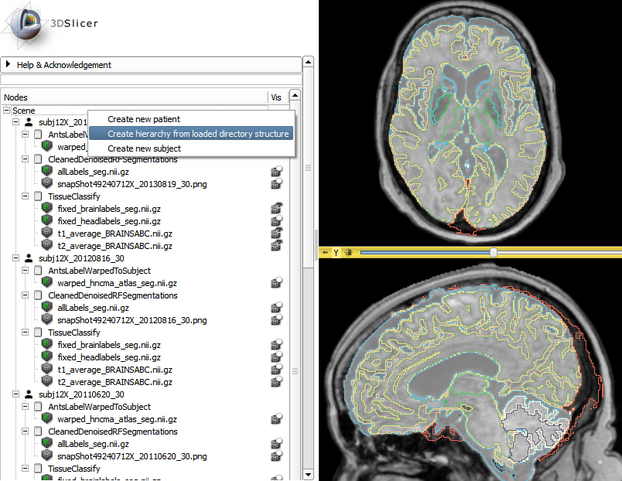Difference between revisions of "Documentation/Nightly/Modules/SubjectHierarchy"
Max.smolens (talk | contribs) m (Fix typos) |
|||
| Line 24: | Line 24: | ||
<!-- ---------------------------- --> | <!-- ---------------------------- --> | ||
{{documentation/{{documentation/version}}/module-section|Module Description}} | {{documentation/{{documentation/version}}/module-section|Module Description}} | ||
| − | The {{documentation/modulename}} module acts as a central data-organizing point in Slicer. All DICOM data is | + | The {{documentation/modulename}} module acts as a central data-organizing point in Slicer. All DICOM data is automatically added to the tree. Non-DICOM data can be parsed if loaded from a local directory structure, or has to be manually added (non-SH nodes are the ones on the bottom with no icons). |
Subject hierarchy nodes provide features for the underlying data nodes, including cloning, bulk transforming, bulk show/hide, type-specific features, and basic node operations such as delete or rename. Additional plugins can provide other type-specific features and general operations, see [[Documentation/Labs/SubjectHierarchy|Subject hierarchy labs page]] | Subject hierarchy nodes provide features for the underlying data nodes, including cloning, bulk transforming, bulk show/hide, type-specific features, and basic node operations such as delete or rename. Additional plugins can provide other type-specific features and general operations, see [[Documentation/Labs/SubjectHierarchy|Subject hierarchy labs page]] | ||
| Line 50: | Line 50: | ||
* Data loaded from '''DICOM''' are automatically added to the tree in the right structure (patient, study, series) | * Data loaded from '''DICOM''' are automatically added to the tree in the right structure (patient, study, series) | ||
* '''Non-DICOM''' data also appears automatically in Subject hierarchy. There two ways are two ways to organize them in hierarchy | * '''Non-DICOM''' data also appears automatically in Subject hierarchy. There two ways are two ways to organize them in hierarchy | ||
| − | ** 'Create hierarchy '''from loaded | + | ** 'Create hierarchy '''from loaded directory structure'''' action in the context menu of the scene (see bottom screenshot). This organizes the nodes according to the local file structure they have been loaded from. |
** Drag&drop manually under a hierarchy node | ** Drag&drop manually under a hierarchy node | ||
* Nodes can be drag&dropped under other nodes, thus re-arranging the tree | * Nodes can be drag&dropped under other nodes, thus re-arranging the tree | ||
| Line 58: | Line 58: | ||
** '''Delete''': Delete both data node and SH node | ** '''Delete''': Delete both data node and SH node | ||
** '''Rename''': Rename both data node and SH node | ** '''Rename''': Rename both data node and SH node | ||
| − | ** '''Clone''': Creates a copy of the selected node that will be | + | ** '''Clone''': Creates a copy of the selected node that will be identical in every manner. Its name will contain a '_Copy' postfix |
** '''Edit properties''': If the role of the node is specified (i.e. its icon is not a question mark), then the corresponding module is opened and the node selected (e.g. Volumes module for volumes) | ** '''Edit properties''': If the role of the node is specified (i.e. its icon is not a question mark), then the corresponding module is opened and the node selected (e.g. Volumes module for volumes) | ||
** '''Create child...''': Create a node with the specified type | ** '''Create child...''': Create a node with the specified type | ||
Revision as of 19:34, 7 August 2015
Home < Documentation < Nightly < Modules < SubjectHierarchy
|
For the latest Slicer documentation, visit the read-the-docs. |
Introduction and Acknowledgements
| |||||||
|
Module Description
The SubjectHierarchy module acts as a central data-organizing point in Slicer. All DICOM data is automatically added to the tree. Non-DICOM data can be parsed if loaded from a local directory structure, or has to be manually added (non-SH nodes are the ones on the bottom with no icons). Subject hierarchy nodes provide features for the underlying data nodes, including cloning, bulk transforming, bulk show/hide, type-specific features, and basic node operations such as delete or rename. Additional plugins can provide other type-specific features and general operations, see Subject hierarchy labs page
Use Cases
TutorialsNone specifically for Subject Hierarchy yet Panels and their use
Contains all the objects in the Subject hierarchy in a tree representation
How to
|
Similar Modules
References
- Additional information on Subject hierarchy labs page
- Manual editing of contours can be done in the Contours module
Information for Developers
- TODO: Guideline for writing plugins (role and function), adding context menu actions (scene/node, handle/create), defining child levels
- Glossary of all the used terms in SlicerRT



